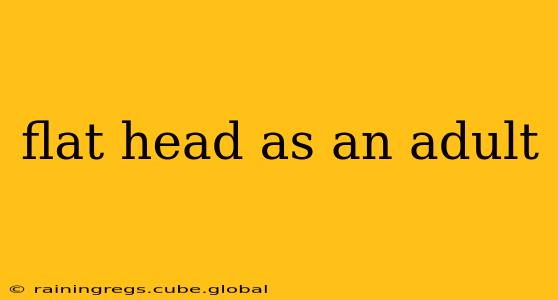A flat head, also known as plagiocephaly, can be a concern for adults, although it's more commonly noticed in infants. While a slightly asymmetrical head shape is common, a significantly flattened head in adulthood often points to an underlying condition that may require medical attention. This article delves into the causes, symptoms, and treatment options for a flat head in adults.
What Causes a Flat Head in Adults?
Several factors can contribute to a flat head in adulthood. It's crucial to understand that the causes differ significantly from those seen in infants. Unlike infant plagiocephaly, which is often positional, adult flat heads are rarely due to sleeping habits.
1. Craniosynostosis (Premature Closure of Skull Sutures):
While often diagnosed in infancy, craniosynostosis can sometimes present later in life with milder symptoms. This condition involves the premature fusion of the skull's sutures, the fibrous joints that connect the skull bones. This can lead to abnormal head shape and potentially affect brain development. While less common in adults, it's a significant consideration.
2. Positional Plagiocephaly (Adult-Onset):
While rare, adult-onset positional plagiocephaly can occur due to prolonged pressure on one side of the head. This might result from prolonged sleeping positions, particularly in individuals with limited mobility or those recovering from injury or surgery.
3. Trauma:
Head injuries, even those that heal without significant immediate symptoms, can sometimes result in a noticeable flattening of the skull over time. This is especially true for injuries that affect the skull's growth plates.
4. Underlying Medical Conditions:
Certain medical conditions can indirectly contribute to a flat head. For example, some genetic disorders or bone diseases may affect skull development and shape.
5. Congenital Conditions:
Some congenital conditions may present later in life with a noticeable flattening of the skull. These conditions often involve issues with bone development and growth.
What are the Symptoms of a Flat Head in Adults?
Symptoms beyond the visible flattening itself can vary depending on the underlying cause. Some individuals may experience:
- Asymmetrical head shape: One side of the head appears flatter than the other.
- Headaches: Particularly if the flat head is due to trauma or craniosynostosis.
- Facial asymmetry: In some cases, facial features may also be affected.
- Scalp tenderness: Possible with trauma or underlying bone conditions.
- Cognitive impairments (in severe cases): Craniosynostosis, if left untreated, can lead to pressure on the brain and cognitive issues. This is less likely in adult-onset cases.
How is a Flat Head in Adults Diagnosed?
Diagnosing the cause of a flat head in an adult requires a thorough medical evaluation. The doctor will likely conduct a physical examination, reviewing the patient's medical history and performing imaging studies such as:
- X-rays: To assess the skull's structure and identify any abnormalities.
- CT scans: Provides detailed images of the skull bones.
- MRI scans: Used to visualize the brain and surrounding tissues to rule out other problems.
How is a Flat Head in Adults Treated?
Treatment for a flat head in an adult depends entirely on the underlying cause. In cases of positional plagiocephaly, adjusting sleeping positions and using supportive pillows might help. However, for more serious conditions like craniosynostosis, surgical intervention might be necessary to correct the skull shape. Surgical options vary depending on the severity and location of the bone fusion. Non-surgical options, like helmet therapy, are generally not effective in adults.
Can a Flat Head in Adults be Prevented?
Prevention strategies depend on the cause. If trauma is a contributing factor, preventative measures such as wearing helmets during risky activities are essential. Early diagnosis and treatment of underlying medical conditions are also crucial to minimize the potential for skull deformity.
Is a Flat Head in Adults Always a Medical Problem?
No, a slightly asymmetrical head shape is often within the normal range of variation. However, a significant flattening, accompanied by other symptoms like headaches or facial asymmetry, warrants medical attention.
What are the Long-Term Effects of an Untreated Flat Head?
The long-term effects depend heavily on the underlying cause. Untreated craniosynostosis can lead to increased intracranial pressure, potentially impacting brain development and function. In less severe cases, the main long-term effect might simply be cosmetic. Seeking medical advice is essential to understand any potential long-term consequences specific to your situation.
This information is for general knowledge and does not constitute medical advice. Always consult a healthcare professional for diagnosis and treatment of any medical condition.
